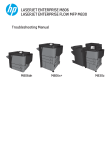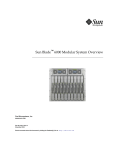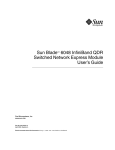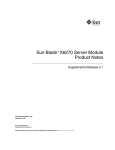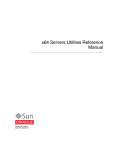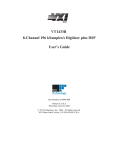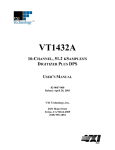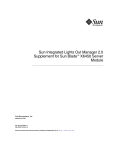Download Sun Blade X6275 Server Module Product Notes
Transcript
Sun Blade X6275 Server Module Product Notes Part No.: Part No.: E20849-04, May 2013 The Sun Blade X6275 Server Module Product Notes contains late-breaking information about the Oracle Sun Blade X6275 server module. Copyright © 2009, 2011, Oracle and/or its affiliates. All rights reserved. This software and related documentation are provided under a license agreement containing restrictions on use and disclosure and are protected by intellectual property laws. Except as expressly permitted in your license agreement or allowed by law, you may not use, copy, reproduce, translate, broadcast, modify, license, transmit, distribute, exhibit, perform, publish, or display any part, in any form, or by any means. Reverse engineering, disassembly, or decompilation of this software, unless required by law for interoperability, is prohibited. The information contained herein is subject to change without notice and is not warranted to be error-free. If you find any errors, please report them to us in writing. If this is software or related software documentation that is delivered to the U.S. Government or anyone licensing it on behalf of the U.S. Government, the following notice is applicable: U.S. GOVERNMENT RIGHTS. Programs, software, databases, and related documentation and technical data delivered to U.S. Government customers are "commercial computer software" or "commercial technical data" pursuant to the applicable Federal Acquisition Regulation and agency-specific supplemental regulations. As such, the use, duplication, disclosure, modification, and adaptation shall be subject to the restrictions and license terms set forth in the applicable Government contract, and, to the extent applicable by the terms of the Government contract, the additional rights set forth in FAR 52.227-19, Commercial Computer Software License (December 2007). Oracle USA, Inc., 500 Oracle Parkway, Redwood City, CA 94065. This software or hardware is developed for general use in a variety of information management applications. It is not developed or intended for use in any inherently dangerous applications, including applications which may create a risk of personal injury. If you use this software or hardware in dangerous applications, then you shall be responsible to take all appropriate fail-safe, backup, redundancy, and other measures to ensure the safe use. Oracle Corporation and its affiliates disclaim any liability for any damages caused by use of this software or hardware in dangerous applications. Oracle and Java are registered trademarks of Oracle and/or its affiliates. Other names may be trademarks of their respective owners. AMD, Opteron, the AMD logo, and the AMD Opteron logo are trademarks or registered trademarks of Advanced Micro Devices. Intel and Intel Xeon are trademarks or registered trademarks of Intel Corporation. All SPARC trademarks are used under license and are trademarks or registered trademarks of SPARC International, Inc. UNIX is a registered trademark licensed through X/Open Company, Ltd. This software or hardware and documentation may provide access to or information on content, products, and services from third parties. Oracle Corporation and its affiliates are not responsible for and expressly disclaim all warranties of any kind with respect to third-party content, products, and services. Oracle Corporation and its affiliates will not be responsible for any loss, costs, or damages incurred due to your access to or use of third-party content, products, or services. _____________________________________________________________________________________________________________ Copyright © 2009, 2011, Oracle et/ou ses affiliés. Tous droits réservés. Ce logiciel et la documentation qui l’accompagne sont protégés par les lois sur la propriété intellectuelle. Ils sont concédés sous licence et soumis à des restrictions d’utilisation et de divulgation. Sauf disposition de votre contrat de licence ou de la loi, vous ne pouvez pas copier, reproduire, traduire, diffuser, modifier, breveter, transmettre, distribuer, exposer, exécuter, publier ou afficher le logiciel, même partiellement, sous quelque forme et par quelque procédé que ce soit. Par ailleurs, il est interdit de procéder à toute ingénierie inverse du logiciel, de le désassembler ou de le décompiler, excepté à des fins d’interopérabilité avec des logiciels tiers ou tel que prescrit par la loi. Les informations fournies dans ce document sont susceptibles de modification sans préavis. Par ailleurs, Oracle Corporation ne garantit pas qu’elles soient exemptes d’erreurs et vous invite, le cas échéant, à lui en faire part par écrit. Si ce logiciel, ou la documentation qui l’accompagne, est concédé sous licence au Gouvernement des Etats-Unis, ou à toute entité qui délivre la licence de ce logiciel ou l’utilise pour le compte du Gouvernement des Etats-Unis, la notice suivante s’applique : U.S. GOVERNMENT RIGHTS. Programs, software, databases, and related documentation and technical data delivered to U.S. Government customers are "commercial computer software" or "commercial technical data" pursuant to the applicable Federal Acquisition Regulation and agency-specific supplemental regulations. As such, the use, duplication, disclosure, modification, and adaptation shall be subject to the restrictions and license terms set forth in the applicable Government contract, and, to the extent applicable by the terms of the Government contract, the additional rights set forth in FAR 52.227-19, Commercial Computer Software License (December 2007). Oracle America, Inc., 500 Oracle Parkway, Redwood City, CA 94065. Ce logiciel ou matériel a été développé pour un usage général dans le cadre d’applications de gestion des informations. Ce logiciel ou matériel n’est pas conçu ni n’est destiné à être utilisé dans des applications à risque, notamment dans des applications pouvant causer des dommages corporels. Si vous utilisez ce logiciel ou matériel dans le cadre d’applications dangereuses, il est de votre responsabilité de prendre toutes les mesures de secours, de sauvegarde, de redondance et autres mesures nécessaires à son utilisation dans des conditions optimales de sécurité. Oracle Corporation et ses affiliés déclinent toute responsabilité quant aux dommages causés par l’utilisation de ce logiciel ou matériel pour ce type d’applications. Oracle et Java sont des marques déposées d’Oracle Corporation et/ou de ses affiliés.Tout autre nom mentionné peut correspondre à des marques appartenant à d’autres propriétaires qu’Oracle. AMD, Opteron, le logo AMD et le logo AMD Opteron sont des marques ou des marques déposées d’Advanced Micro Devices. Intel et Intel Xeon sont des marques ou des marques déposées d’Intel Corporation. Toutes les marques SPARC sont utilisées sous licence et sont des marques ou des marques déposées de SPARC International, Inc. UNIX est une marque déposée concédée sous licence par X/Open Company, Ltd. Please Recycle Contents Preface 1. ix System Software Release Features Hardware Configurations Firmware Versions 1 2 Supported Operating Systems Additional Software Optional Software 1 3 3 4 Supported Modular System Chassis 4 Sun Blade 6000 Network Express Modules (NEMs) Power Management Support in ILOM ▼ 5 How to Use the Power Budget Feature in ILOM: Documentation for the Power Budget Feature 2. Hardware, Firmware, and BIOS Notes and Issues Hardware Notes and Issues FMOD Caution 5 5 6 7 7 7 Setup and Power-On Recommendations for the Sun Blade 6000 or 6048 System Module Chassis 8 ▼ Setup and Power-on Recommendations With an Empty System Chassis 8 iii ▼ Setup and Power-on Recommendations With a Preconfigured System Chassis 9 PCI Express Module Assignment In the Sun Blade X6048 System Module Chassis 10 Memory Reference Code Issue Causes Faulty DIMM to Be Misidentified (6964312) 10 Identifying a Node’s Onboard Device Versus a Node’s PCIe EM (7072665) Firmware and BIOS Features and Issues 11 BIOS Options to Enable/Disable Any Available USB Ports (6880508) Intel SMM Security Issue (6857157) 11 12 12 Sun StorageTek Dual 4 Gb Fibre Channel Dual GbE ExpressModule Host Bus Adapter (Emulex SG-XPCIE2FCGBE-E-Z) is Sometimes Not Visible in BIOS 12 Flash Modules Not Found After Power Cycle (6798255) 13 (Fixed) System Unable to Boot from Fibre Channel Express Modules (6804868) 13 (Fixed) BIOS Does Not Execute Set SEL time Command During POST (6879630) 13 CPU and DIMM FRU Data Can Be Lost After SP Firmware Upgrade (6913602) 14 Updating Firmware That Includes New CPLD Version PCIe Link Speed Reduced With BIOS 10.2.6.0 (6994690) 3. Server Management and ILOM Notes and Issues General Notes and Issues ▼ 14 15 15 Dynamic Field Replaceable Unit (FRU) ID Information Restricted Bash Shell 14 15 16 Entering the Restricted Shell 16 Power Values in ILOM Web Interface 16 Details of the Error Message 17 Reading Sun Blade X6275 Power Consumption in the CMM Enabling and Disabling the Sun Cooling Door iv Sun Blade X6275 Server Module Product Notes • May 2013 18 17 Sun Blade X6275 Does Not Boot if the CMM is Off-Line 18 Locate LED Programmed to Stay On For 30 Minutes (6793865) Proving Physical Presence (6881237) 18 19 Understanding the Node available_power Statistic (6892763) ILOM Fixed and Open Issues ILOM Fixed Issues 19 21 21 (Fixed) Sensor List For X6275 Blade Node 1 Is Not Correct When In Sun Blade 6048 (6924167) 22 (Fixed) Blades Cannot Clear Fan Faults (6920801) 22 (Fixed) During Chassis Boot, at Least One Sun Blade X6275 Server Module Must Be Installed 22 (Fixed) pecitool Shows Wrong CPU Number (6890473) 22 (Fixed) Hostdiag Reports CPU Number Reversed In 2.0.3.xx and 3.0.4.10 (6857083) 23 (Fixed) FRU Properties Change Intermittently (6804445) 23 (Fixed) Erroneous Chassis Hot Insertion Event Logged After CMM Reboot (6797938) 23 (Fixed) Host Intermittently Cannot Connect to RKVM Session (6783184) 23 (Fixed) Blade Node1 System Event Log Lists False /SYS/NEM1 or /SYS/PEM Hot Removal Messages (6791106) 24 (Fixed) CMM ILOM Interface Becomes Unresponsive After Repeated Use (6798257) 24 (Fixed) BIOS Does Not Set Service Processor Time (6801525) 24 (Fixed) Confusing Critical Events Logged in SEL at Service Processor Boot (6808890) 25 (Fixed) ipmiflash -I pci Causes SP to Lose All Network Connections (6850823) 25 (Fixed) ILOM Configurations Are Preserved During Upgrade Even After Specifying “No” (6971164) 26 ILOM Open Issues 27 Resetting the SP to Factory Defaults With Host Powered On Causes Permitted Power Miscalculation (6960011) 27 Contents v Set Port Sharing Error Message From SP via SP Web Interface (6895495) Green LED Should Slow Blink (1 Hz) During FW Upgrade (6862377) Products Cannot Be Registered, (6861523) 28 28 29 Ipmiflash Over USB Interface Fails Due to Unexpected Response to Fileupload Command (6856369) 29 Setting the Serial Baud Rate in the System BIOS Does Not Propagate to the Service Processor (6784341) 30 CMM ILOM Becomes Unresponsive With Multiple CLI Sessions Open (6780171) 30 Blade Power On Issues With the start /SYS Command (6784708) 30 Missing Warning Message While Doing Backup Configuration Without Pass Phrase (6859295) 31 After CMM is Reset Fan and Blade Events in Blade Event Logs Show Different Events (6864597) 31 Powering On Batches of Blades Might Cause a Node to Fail to Power On (6813202) 32 More Than Ten Open ILOM CLI Sessions Degrades Performance (6787190) 32 Resetting the SP to Factory Defaults With Host Powered On Causes DIMM FRU Information to Be Lost (6970476, 6913602) 33 4. Software Notes and Issues General OS Issues 35 35 (Sun Blade X6275 1GbE only) Rx_mixed Errors (6913783) 36 Softcap Does Not Work When Host is Powered on After SP Reboots (6890841) 36 PCIe ExpressModule Native Hot Plug Does Not Work (6804272) 36 Setting the Power Management Hardcap Power Limit Prior to Booting the System Does Not Control System Power 37 OpenSolaris 37 Oracle Solaris OS Linux 38 Oracle Solaris OS Issues vi 37 38 Sun Blade X6275 Server Module Product Notes • May 2013 InifiniBand Devices Show Low Throughput on Solaris 10 10/09 (6901056) 38 Solaris 10 5/09 Kernel Warnings: cpu_acpi error parsing _TSS for CPU instance x. 39 Hotplug of Express Modules Containing a PCIe Bridge Chip Do Not Work With Solaris 10 5/09 and OpenSolaris 2009.06 39 CentOS Issues 39 PCI: Ignore Bogus Resource 6 [0:0] Error Message (6781943) Oracle Linux and Red Hat Enterprise Linux (RHEL) Issues 40 40 Hot Plugging ExpressModules Containing a PCIe Bridge Chip Does Not Work With Red Hat Enterprise Linux 4.8 40 PCI: Ignore Bogus Resource 6 [0:0] Error Message (6781943) 41 PCI: BIOS Bug MCFG area at e0000000 is not E820-reserved Error Message 41 Sound Server Informational Message: Error While Initializing the Sound Driver 42 Setting the Power Management Hardcap Power Limit Prior With the Host Power Off Does Not Control System Power (7009666) 42 SUSE Linux Enterprise Server (SLES) Issues 43 Unable to Start openibd and opensmd and Unable to load HCA driver on SLES 11 (6812736) 43 PCIEHP Hot-Plug Default Driver Is Not Supported by SLES10 SP2 and SP3 44 Additional Software Driver Added To SLES11 Might Not Work 44 Hotpluggable processor device is not present Error Message Windows Server 2008 Issues 45 45 Hot-Plug is Not Supported By Windows 2008 For Some ExpressModules (6793369) 45 Windows Server 2008 Limited Support on Sun Blade X6275 5. Documentation Issues 45 47 Error on Service Card for RTC Battery Replacement 47 Contents vii viii Sun Blade X6275 Server Module Product Notes • May 2013 Preface The Sun Blade X6275 Server Module Product Notes contains late-breaking information about the Oracle Sun Blade X6275 server module. Related Documents To see a list of the Sun Blade™ X6275 server module documentation, refer to the Getting Started Guide that is packed with your system and also posted at the product’s documentation site. Translated versions of some of these documents are available at the web product documentation page in Simplified Chinese, French, and Japanese. English documentation is revised more frequently and might be more up-to-date than the translated documentation. See TABLE P-1 for more information. ix Oracle Online TABLE P-1 Sun Blade X6275 Server Module Online Pages Page URL Description Sun Blade X6275 product page http://www.oracle.com/us/products/serve rs-storage/servers/previousproducts/index.html Describes the product and provides links to downloads, OS support, and so on. Sun Blade X6275 product documentation http://download.oracle.com/docs/cd/E194 64-01/index.html Navigate to the Sun Blade X6275 server module document page and then download PDF and view HTML documents. Support http://support.oracle.com Obtain technical support and download patches. Training http://education.oracle.com Learn about Oracle courses. Warranty http://www.oracle.com/support/collatera l/oracle-hardware-warranty.pdf Obtain specific details regarding your warranty. General Oracle Softwarre Product Updates http://www.oracle.com/technology/softwa re/sun_az_index.html Click the product name in the list to get downloads and other information. x Sun Blade X6275 Server Module Product Notes • May 2013 CHAPTER 1 System Software Release Features This chapter contains the following sections describing the system software release features for the Sun Blade X6275 server module: ■ “Hardware Configurations” on page 1 ■ “Firmware Versions” on page 2 ■ “Supported Operating Systems” on page 3 ■ “Additional Software” on page 3 ■ “Optional Software” on page 4 ■ “Supported Modular System Chassis” on page 4 ■ “Power Management Support in ILOM” on page 5 Hardware Configurations These are the supported versions of the Sun Blade X6275 server module: ■ Sun Blade X6275 IB server module installed into a Sun Blade 6048 modular system chassis with InfiniBand QDR Switched Network Express Module (Q Nem) ■ Sun Blade X6275 1GbE server module with integrated GbE support installed into a Sun Blade 6000 or Sun Blade 6048 modular system chassis 1 Firmware Versions The following table lists the released versions of the server module firmware. TABLE 1-1 Sun Blade X6275 Server Module Released Firmware Versions Software Release ILOM Firmware 2.8 FMOD Firmware Minimum CMM Firmware Required System BIOS CPLD IB Firmware* 3.0.10.10.d (r79845) 10.02.12.00 17 2.7.8100_2.9 D20R 3.0.10.15 2.7 3.0.10.10.c (r67705) 10.02.10.00 17 2.7.8100_2.9 D20R 3.0.10.15 2.6 3.0.10.10 (r61375) 10.02.09.00 17 2.7.8100_2.9 D20R 3.0.10.15 2.5 3.0.10.10 (r59586) 10.02.07.00 17 2.7.8100_2.9 D20R 3.0.10.15 2.4 3.0.10.10 (r57417) 10.02.04.00 17 2.7.000-2.5 D20R 3.0.10.15 2.3 3.0.8.10 (r53304) 10.01.41.00 17 2.7.000-2.5 D20R 3.0.6.11b 2.2 3.0.8.10 (r50660) 10.01.40.00 17 2.7.000 D20R 3.0.6.11b 2.1 3.0.8.10 (r48988) 10.01.39.00 17 2.6.200 49M 3.0.6.11b 2.0 3.0.4.10 (r47119) 10.01.32.00 14 2.6.200 49M 3.0.6.11 1.1 2.0.3.17 (r45307) 10.01.28.00 14 2.6.0 49M 2.0.3.13 1.0 2.0.3.13 (r42414) 10.01.24.00 14 2.6.0 49M 2.0.3.13 Note – *The IB firmware consists of three components: a .mlx raw firmware file, a .ini configuration file specific to X6275 and a .rom file. Note – The latest firmware updates for the Sun Blade X6275 server module are available from the product page, listed in “Oracle Online” on page x. 2 Sun Blade X6275 Server Module Product Notes • May 2013 Supported Operating Systems The following operating systems are supported on the Sun Blade X6275 server module using the latest software release: ■ Oracle Solaris 10 5/09 (with patch 141782-02) ■ Oracle Solaris 10 10/09 ■ Oracle Solaris 10 09/10 -- support for 1GbE models only ■ Oracle Linux 4.8 (64-bit) ■ Oracle Linux 5.3 (64-bit) ■ Oracle Linux 5.4 (64-bit) ■ Oracle Linux 5.5 (64-bit) ■ Red Hat Enterprise Linux (RHEL) 4.8 (64-bit) ■ Red Hat Enterprise Linux (RHEL) 5.3 (64-bit) ■ Red Hat Enterprise Linux (RHEL) 5.4 (64-bit) ■ Red Hat Enterprise Linux (RHEL) 5.5 (64-bit) ■ SUSE Linux Enterprise Server (SLES) 10 SP2 (64-bit) ■ SUSE Linux Enterprise Server (SLES) 10 SP3 (64-bit) ■ SUSE Linux Enterprise Server (SLES) 11 (64-bit) ■ SUSE Linux Enterprise Server (SLES) 11 SP1 (64-bit) ■ CentOS 5.3 (64-bit) ■ Microsoft Windows Server 2008 (64-bit) -- support for this operating system beginning with server module software release 1.1 Note – For Oracle Linux, see http://www.oracle.com/us/technologies/linux/index.html for support and download information. Additional Software The following additional software is available for your server and can be downloaded from the Oracle web site: ■ Tools and Drivers CD/DVD (available on the web as an ISO image). Contains all required software for the server, including: Chapter 1 System Software Release Features 3 ■ ■ Server-specific drivers for all supported operating systems. ■ Server-specific firmware (BIOS/ILOM, FMod, Mellanox ConnectX 10G HCA). ■ IPMItool, a simple command-line interface that is useful for managing IPMIenabled devices. Available as a supplement to ILOM. ■ SNMP mibs, for use with management software that supports SNMP. ■ PC-Check (version 6.27s), a system diagnostics utility available through ILOM Remote Control Diagnostics, or run separately. Oracle Validation Test Suite (also known as “SunVTS”) Bootable Diagnostic, version 7.0ps8 Optional Software Optional software is available for your server. Some of it might be preinstalled, downloaded, or purchased as an option (Oracle Solaris, Oracle Java Enterprise System, SunVTS, Oracle Enterprise Manager Ops Center). There are also optional software tools available on the Tools and Drivers CD/DVD for your server. Supported Modular System Chassis The Sun Blade X6275 server module is supported for use in a Sun Blade 6000/6048 Modular System chassis. Additionally, the Chassis Monitoring Module (CMM) for the Sun Blade 6000 and 6048 Modular System chassis must meet the following minimum compatibility requirements. TABLE 1-2 Chassis Monitoring Module Minimum Firmware Version CMM ILOM Firmware Version Supported Chassis for X6275 ILOM Firmware Build 2.0.3.13 Sun Blade 6048 Modular System Chassis r47352 3.0.6.11b Sun Blade 6000 Modular System Chassis r48988 For the required CMM firmware version for your software release, see “Firmware Versions” on page 2. 4 Sun Blade X6275 Server Module Product Notes • May 2013 Sun Blade 6000 Network Express Modules (NEMs) There are three Sun Blade 6000 NEMs supported for X6275 1GbE Server Module: ■ Gigabit Ethernet (CU) 10-port Pass-Thru Network Express Module (Recommended) ■ Sun Blade 6000 Virtualized Multi-Fabric 10GbE Network Express Module ■ Sun Blade 6000 Multi-Fabric Network Express Module ■ Sun Blade 6000 10GbE Multi-Fabric Network Express Module Note – The Sun Blade X6275 1GbE server module only leverages the GbE Pass-Thru support provided in the above mentioned NEMs. Power Management Support in ILOM The power management capping feature is a capability within the service processor (ILOM) that monitors measurable values, determines whether adjustments are needed in consumed power, then applies power capping methods to achieve the adjustment. You can adjust the power capping by setting the target power consumption in ILOM where you can monitor: ■ IPMI current/voltage sensors to keep track of total system power ■ Settings to adjust the desired maximum power level of the system. The Power Management settings are available through IPMI, SNMP, CLI, and the Web interface. ▼ How to Use the Power Budget Feature in ILOM: 1. Determine the workload that will operate on the server. 2. Enable power limiting in ILOM. 3. Set the Target Limit property in ILOM that is near (for example, at or slightly above) to the workload’s normal operating power consumption. 4. Set the capping policy to be either hardcap or softcap. Chapter 1 System Software Release Features 5 5. Determine the violation actions to be taken when the power limit cannot be achieved within the grace period. 6. If power cannot be capped to the value provided in Target Limit, a Violation warning will be seen in ILOM. Documentation for the Power Budget Feature See the Oracle Integrated Lights Out Manager (ILOM) 3.0 Feature Update and Release Notes, (820-7329) for detailed information. The Integrated Lights Out Manager (ILOM) 3.0 document collection is available from: http://download.oracle.com/docs/cd/E19860-01/index.html Note – For the X6275 server module, the minimum operating system support for power management is: Oracle Solaris 10 10/09, SUSE Linux Enterprise Server 11, Oracle Linux 5.4, and Red Hat Enterprise Linux 5.4. 6 Sun Blade X6275 Server Module Product Notes • May 2013 CHAPTER 2 Hardware, Firmware, and BIOS Notes and Issues This chapter contains the following sections describing hardware, firmware and BIOS issues that apply to the Sun Blade X6275 server module: ■ “Hardware Notes and Issues” on page 7 ■ “Firmware and BIOS Features and Issues” on page 11 Hardware Notes and Issues ■ “FMOD Caution” on page 7 ■ “Setup and Power-On Recommendations for the Sun Blade 6000 or 6048 System Module Chassis” on page 8 ■ “PCI Express Module Assignment In the Sun Blade X6048 System Module Chassis” on page 10 ■ “Memory Reference Code Issue Causes Faulty DIMM to Be Misidentified (6964312)” on page 10 ■ “Identifying a Node’s Onboard Device Versus a Node’s PCIe EM (7072665)” on page 11 FMOD Caution Extra attention must be paid to flash modules when they are inserted or removed with the blades or when powering the chassis on/off. The following rules must be followed. 7 ■ After AC power cycling the Sun Blade X6275 Server Module, that is, removing the blade from the chassis or powering off the shelf, you must wait for 20 seconds before reinserting the blade or powering on the shelf. Check to see that the green LED on the motherboard (next to FMOD) is no longer lit. It will take approximately 20 seconds. Caution – Damage to the flash module can occur if the FMOD is installed (while the green LED is lit) and the flash modules might not be recognized by the host nodes. ■ When the X6275 modules are inserted in the chassis for the first time, wait two minutes before pulling it out or powering the shelf down. This is the time required to charge the supercaps. The same action applies when the shelf or blade is powered down for some time. When the blade is inserted never pull it out quickly. Wait for two minutes before removing the blade. ■ If the FMOD does become corrupted use the Sun supplied utility to perform a low level format. Once the format is done, you will need to AC power cycle the blade by pulling it out. Wait a minimum of two minutes before plugging the blade back in. Setup and Power-On Recommendations for the Sun Blade 6000 or 6048 System Module Chassis The recommended setup and power-on method for the Sun Blade 6000/6048 System Module chassis with X6275 server modules is different depending on whether you are starting with an empty system chassis, or a pre-configured system chassis. Follow the recommended procedure for your installation as described below. ▼ Setup and Power-on Recommendations With an Empty System Chassis 1. Before installing server blades, make sure that all of the chassis components are installed (power supplies, fans, NEMs, EMs, etc.). 2. Connect required I/O cables for the chassis (Ethernet, InfiniBand, etc.). 3. Install and fully seat Blade 0. 4. Attach all six AC power cables from the system chassis power interface module to a power source. The chassis automatically applies main power to all blades in the chassis after power is provided to the power supplies. Ensure that all power LEDs are lit. 8 Sun Blade X6275 Server Module Product Notes • May 2013 5. Set up your CMM IP address with a DHCP/Static address. 6. Verify the CMM network and check/setup the blade SP network. 7. Install other blades with a 30 second interval between each blade insertion. For example, after Blade 0 has been powered, wait 30 seconds. Then install and fully seat Blade 1 and wait 30 seconds for them to power on. Then install and fully install Blade 2 and wait 30 seconds for them to power-on. Repeat the process until all blades are installed. 8. Verify that no fault (amber) LEDs are lit on blade or chassis components (CMM, PSU, blades, etc.). If fault LEDs are lit, follow the troubleshooting procedures described in the system Diagnostics Guide and refer to the Product Notes for any known issues. ▼ Setup and Power-on Recommendations With a Preconfigured System Chassis 1. Connect required I/O cables for the chassis (Ethernet, InfiniBand, etc.). 2. Attach all six AC power cables from the system chassis power interface module to a power source. The chassis automatically applies main power to all modules in the chassis after power is provided to the power supplies. Ensure that all power LEDs are lit. 3. Wait five minutes for the CMM to boot and then verify/setup the CMM network. 4. Login to the CMM CLI, check/setup the blade SP network and verify the MAC address and collect the SP IP address for each node by entering the show command from the CMM CLI prompt. For example: -> show /CH/BL0/SP/network For any node that does not display network information, reseat the blade, wait 5 minutes, and recheck the SP network information. 5. Verify that no fault (amber) LEDs are lit on blade or chassis components (CMM, PSU, blades, etc.), and that the blades are showing normal operation: ■ If fault LEDs are lit, follow the troubleshooting procedures described in the system Diagnostics Guide and refer to the corresponding Product Notes for any known issues. ■ If the green OK LED is blinking or not on for a blade server, press the power button for the blade to see if it will power on. The power-on sequence can take one to two minutes. Alternatively, you can log into each node’s ILOM CLI and start the host by entering the command from the CLI prompt: Chapter 2 Hardware, Firmware, and BIOS Notes and Issues 9 -> start /SYS For any host that does not boot, reseat the blade. PCI Express Module Assignment In the Sun Blade X6048 System Module Chassis In the Sun Blade 6048 System Module chassis, there are two PCI EM slots assigned to each blade slot. The slots are numbered PCI EM 0.0 to 11.1 right to left as viewed from the rear of the chassis and assigned to blade slots as shown below: When the Sun Blade X6275 server module is installed in a blade slot, its two PCI EM slots are assigned as follows: ■ PCI EM x.0 is assigned to blade Node1 ■ PCI EM x.1 is assigned to blade Node0 Where x represents the slot number in which the blade is installed. Memory Reference Code Issue Causes Faulty DIMM to Be Misidentified (6964312) Due to an issue with the Memory Reference Code (MRC), if a DIMM fails, the system might flag the wrong DIMM as the failing DIMM. This misidentification can happen to DIMMs that reside on the same channel as the faulty DIMM. 10 Sun Blade X6275 Server Module Product Notes • May 2013 Workaround: If the system error log or FMA utilities show multiple DIMM failures in the same channel, do the following: 1. Remove both of the DIMMs flagged as failing from the system. Refer to the Service Manual for more information on removing DIMMs. 2. Install one of the DIMMs in an alternate channel (that has shown no errors). Each processor has three memory channels with two slots per channel (for example, D0/D1 is a channel, D2/D3 is a channel, and D4/D5 is a channel). 3. Reboot the system and look for DIMM errors. 4. If DIMM failures now occur on the alternate channel, the DIMM you installed is faulty and must be relpaced. 5. If there are no errors on the alternate channel, the DIMM you installed is good and the other DIMM is faulty and must be replaced. Identifying a Node’s Onboard Device Versus a Node’s PCIe EM (7072665) If you have a Sun Blade X6275 server module with onboard InfiniBand that has, for example, a network issue, it might be difficult to identify a faulty device if you have other similar devices on the node’s pci bus. When using a unix-based tool such as lspci at the host to find connected PCI devices, output can be interpreted as follows: ■ 02:00.0 refers to the host node’s onboard Mellanox IB ConnectX controller. ■ 08:00.0 refers to the host node’s PCIe EM (which might also use Mellanox IB ConnectX technology). Firmware and BIOS Features and Issues The following firmware and BIOS features and issues apply to the Sun Blade X6275 server module. ■ “BIOS Options to Enable/Disable Any Available USB Ports (6880508)” on page 12 ■ “Intel SMM Security Issue (6857157)” on page 12 ■ “Sun StorageTek Dual 4 Gb Fibre Channel Dual GbE ExpressModule Host Bus Adapter (Emulex SG-XPCIE2FCGBE-E-Z) is Sometimes Not Visible in BIOS” on page 12 Chapter 2 Hardware, Firmware, and BIOS Notes and Issues 11 ■ “Flash Modules Not Found After Power Cycle (6798255)” on page 13 ■ “(Fixed) System Unable to Boot from Fibre Channel Express Modules (6804868)” on page 13 ■ “(Fixed) BIOS Does Not Execute Set SEL time Command During POST (6879630)” on page 13 ■ “CPU and DIMM FRU Data Can Be Lost After SP Firmware Upgrade (6913602)” on page 14 ■ “Updating Firmware That Includes New CPLD Version” on page 14 ■ “PCIe Link Speed Reduced With BIOS 10.2.6.0 (6994690)” on page 14 BIOS Options to Enable/Disable Any Available USB Ports (6880508) There are extra options available in the BIOS Set Up Menu to Enable/Disable any available USB Ports. Note – This feature is available in BIOS version 10.0.39.0 or later. Intel SMM Security Issue (6857157) Security vulnerabilities in the BIOS might allow a local privileged user who has the ability to run fully privileged code to gain access to the CPU’s System Management Mode. Note – This issue is fixed in BIOS version 10.0.39.0 or later. Sun StorageTek Dual 4 Gb Fibre Channel Dual GbE ExpressModule Host Bus Adapter (Emulex SG-XPCIE2FCGBE-E-Z) is Sometimes Not Visible in BIOS On rebooting the system, the Sun StorageTek card occasionally disappears from BIOS and can no longer be used. 12 Sun Blade X6275 Server Module Product Notes • May 2013 Workaround: Power cycle the blade. When the blade powers back on, the card should be visible again. Flash Modules Not Found After Power Cycle (6798255) In rare instances, after power cycling a Sun Blade X6275 server module node, the system might not be able to find the Flash Modules (FMODs). If the flash module is the boot device with an installed operating system, the system will fail to boot. Workaround: If you encounter this problem, remove and reinsert the blade into the blade chassis. After removing the blade from the chassis, you must wait for at least 20 seconds before reinserting the blade. If you do not, the flash modules might not be recognized by the host nodes. (Fixed) System Unable to Boot from Fibre Channel Express Modules (6804868) The Sun Blade X6275 system BIOS does not have enough memory space to load the option ROM code for Fibre Channel Express Module cards and the dual-function Fibre Channel Express Module cards. This means you cannot boot the system from these devices. If this happens, you will receive the following BIOS error: Not enough Space to copy PCI Option ROM Note – This issue is fixed in BIOS version 10.0.28.0 or later. (Fixed) BIOS Does Not Execute Set SEL time Command During POST (6879630) The Sun Blade X6275 system service processor ILOM did not support the Set SEL time command. Therefore, BIOS could not send the RTC time to service processor. BIOS has been changed in parallel with the new fix in service processor ILOM. Note – This issue is fixed in BIOS version 10.0.39.0 or later. Chapter 2 Hardware, Firmware, and BIOS Notes and Issues 13 CPU and DIMM FRU Data Can Be Lost After SP Firmware Upgrade (6913602) After upgrading ILOM/SP firmware for the server, you might not be able to view CPU and/or DIMM FRU data through ILOM. This issue can occur after any ILOM upgrade if the set reset_to_defaults=factory command is issued to reset the SP while the host still powered on. Workaround: To clear this condition, power off the host (from ILOM, issue the stop /SYS command) and then reset SP. Updating Firmware That Includes New CPLD Version If the firmware you are upgrading to includes a new CPLD (Complex Programmable Logic Device) version, you must power off the server module nodes and reseat the blade in the chassis for the server to use the new CPLD code. See “Firmware Versions” on page 2 for firmware release information. Note – If you are downgrading to an earlier firmware version, CPLD will not be downgraded (even if the firmware includes an earlier version of CPLD) and therefore the blade will not need to be reseated in the chassis. PCIe Link Speed Reduced With BIOS 10.2.6.0 (6994690) If your Sun Blade X6275/X6275 M2 server module is running BIOS version 10.2.6.0, the PCIe EM bus speed is reduced to PCIe Gen1 speeds. This issue only affects the Dual Port Quad Data Rate (QDR) InfiniBand HCA PCIe EM card. Other supported PCIe EM cards run at lower speeds and are therefore not affected. There is currently no workaournd for this issue. If you have a Sun Blade X6275 or X6275 M2 server module with a BIOS version lower than 10.2.6.0 and are using the Dual Port Quad Data Rate (QDR) InfiniBand HCA PCIe EM card, do not upgrade the server BIOS to a later version until a fix is available. 14 Sun Blade X6275 Server Module Product Notes • May 2013 CHAPTER 3 Server Management and ILOM Notes and Issues This chapter describes server management and ILOM service processor (SP) issues that apply to the Sun Blade X6275 server module. ■ “General Notes and Issues” on page 15 ■ “ILOM Fixed and Open Issues” on page 21 General Notes and Issues ■ “Dynamic Field Replaceable Unit (FRU) ID Information” on page 15 ■ “Restricted Bash Shell” on page 16 ■ “Power Values in ILOM Web Interface” on page 16 ■ “Reading Sun Blade X6275 Power Consumption in the CMM” on page 17 ■ “Enabling and Disabling the Sun Cooling Door” on page 18 ■ “Sun Blade X6275 Does Not Boot if the CMM is Off-Line” on page 18 ■ “Locate LED Programmed to Stay On For 30 Minutes (6793865)” on page 18 ■ “Proving Physical Presence (6881237)” on page 19 ■ “Understanding the Node available_power Statistic (6892763)” on page 19 Dynamic Field Replaceable Unit (FRU) ID Information The following information is available from the server module ILOM when FRUs are inserted: 15 ■ Installation records when FRUs are inserted ■ Power history (power on time, power events) ■ Temperature history Restricted Bash Shell ILOM provides a restricted shell, which allows access to logs and commands to view and search them such as grep/less. In addition, access to administrative commands such as uptime as well as commands to safely reboot the SP are provided. ▼ Entering the Restricted Shell Use the root account to enter the restricted shell through the spsh shell. Note – You cannot enter the restricted shell from an spsh shell that was spawned through ipmitool. Power Values in ILOM Web Interface From the ILOM web interface, access the power values from Power Management> Allocation > Power Allocation Plan, Target Limit. The value can be in watts or a percent between: ■ Installed Hardware Minimum power (138 watts) and ■ Allocated Power (295 watts). Note – Installed Hardware Minimum power is the recommended minimum power you can set and should be regarded as a reference. Capping the power to this minimum value will have two issues: 1. CPU performance will be severely downgraded. 16 Sun Blade X6275 Server Module Product Notes • May 2013 2. You may see a "power violation" in the CLI and ILOM SEL log as described in “Details of the Error Message” on page 17. This is due to the minimum power calculation which is hard to perfect. The calculation’s accuracy should be taken into account for each component and for different usage patterns. The Violation status occurs since the system is not able to reduce power to below the Installed Hardware Minimum power due to the usage pattern. Caution – To avoid the issue described above, do not cap the power to this minimum value. Details of the Error Message On the "Consumption" tab under "Power Management" in the ILOM Web interface, the following Warning might be seen for the target limit: ■ In case of a hard cap: Warning: /Peak Permitted/ exceeds /Target Limit/ ■ In case of a soft cap: Warning: /Actual Power/ exceeds /Target Limit/. Through the ILOM CLI, the event is recorded as follows: /SP/powermgmt/budget Properties: activation_state = enabled status = violation The ILOM SEL records a IPMI log similar to the following: ID = 10e2 : 10/27/2009 : 14:28:56 : Power Supply : PWRBS : State Asserted Reading Sun Blade X6275 Power Consumption in the CMM As viewed from the Chassis Management Module (CMM) ILOM interface, the power budget as shown in the CMM is on a per blade basis. For the Sun Blade X6275, it shows total power consumption of the blade (both nodes together). Chapter 3 Server Management and ILOM Notes and Issues 17 Enabling and Disabling the Sun Cooling Door A policy has been added to the CMM ILOM to support the Sun Cooling Door that might be used with your chassis. Sun supports two types of cooling doors: the Sun Cooling Door 5200 and the Sun Cooling Door 5600. ■ If your chassis has a Sun Cooling Door installed, you must enable the cooling door policy in the CMM. ■ If your chassis does not have a Sun Cooling Door, you must disable the cooling door policy in the CMM. This is the default. To configure the Sun Cooling Door policy using the ILOM web interface or CLI, see the Sun Integrated Lights Out Manager (ILOM) 3.0 Feature Update and Release Notes, (820-7329) for detailed information. The Integrated Lights Out Manager (ILOM) 3.0 document collection is available from: http://www.oracle.com/pls/topic/lookup?ctx=ilom30&id=homepage Sun Blade X6275 Does Not Boot if the CMM is Off-Line If the Chassis Monitoring Module (CMM) is offline (due to a problem with the CMM or because the CMM is going through the boot process), the Sun Blade X6275 will not power on. Workaround: 1. Ensure that the CMM is online before booting the Sun Blade X6275. 2. To power on the blade, run start -force. Locate LED Programmed to Stay On For 30 Minutes (6793865) According to the IPMI specification, the locate LED on the front of the blade is supposed to turn itself off after 15 seconds. However, Oracle has determined that this might not give the customer sufficient time to physically locate the system. For this reason, Oracle has chosen to deviate from the IPMI specification and set the default time-out value to 30 minutes. You can choose to turn the locate LED off by using one of the following methods: 18 ■ Turn off the locate LED manually by pressing locate button on the blade. ■ Use the ILOM web interface or CLI to turn off the locate LED. Sun Blade X6275 Server Module Product Notes • May 2013 ■ Use the IPMItool chassis identify command to turn off the locate LED by setting the time-out value to zero. Wait 30 minutes for the locate LED to automatically turn off on its own. Proving Physical Presence (6881237) You can use the preconfigured ILOM default user account to recover a lost password or re-create the root account. The default user account cannot be changed or deleted and is only available through a local serial console connection (refer to the Sun Blade X6275 Server Module Service Manual). In order to access the default user account, you must prove physical presence. To prove physical presence for a node of the Sun Blade X6275 server module, press the Locate button for the node on the server module front panel when prompted by ILOM. For information about the server module front panel and indicators, refer to Sun Blade X6275 Server Module Installation Guide. Understanding the Node available_power Statistic (6892763) When using a node’s ILOM CLI to review power consumption, the following command can be used: -> show /SP/powermgmt This displays output similar to: /SP/powermgmt Targets: budget powerconf Properties: actual_power = 56 permitted_power = 190 allocated_power = 190 available_power = 380 threshold1 = 0 threshold2 = 0 Chapter 3 Server Management and ILOM Notes and Issues 19 Where: ■ actual_power displays the current system input power (in watts) consumption. ■ permitted_power displays the maximum power consumption (in watts) expected for the system. ■ available_power displays the input power capacity (in watts) that is available to system components. The CMM uses the available_power number listed in node 0 to determine how much power to allocate to the entire blade. When logged into node 0, the available_power listed is actually the combined available power for the entire blade (node 0 plus node 1). To calculate the available power for node 0, subtract the available_power number listed when logged into node 1 from the total available_power number listed for node 0. 20 Sun Blade X6275 Server Module Product Notes • May 2013 ILOM Fixed and Open Issues This section contains fixed and open issues for Oracle Integrated Lights Out Management (ILOM). ■ “ILOM Fixed Issues” on page 21 ■ “ILOM Open Issues” on page 27 ILOM Fixed Issues The following issues have been fixed. TABLE 3-1 ILOM Fixed Issues Description of Issue Status Release Fixed “(Fixed) Sensor List For X6275 Blade Node 1 Is Not Correct When In Sun Blade 6048 (6924167)” on page 22 Fixed 2.3 “(Fixed) Blades Cannot Clear Fan Faults (6920801)” on page 22 Fixed 2.3 “(Fixed) During Chassis Boot, at Least One Sun Blade X6275 Server Module Must Be Installed” on page 22 Fixed 2.1 “(Fixed) pecitool Shows Wrong CPU Number (6890473)” on page 22 Fixed 2.1 “(Fixed) Hostdiag Reports CPU Number Reversed In 2.0.3.xx and 3.0.4.10 (6857083)” on page 23 Fixed 2.1 “(Fixed) FRU Properties Change Intermittently (6804445)” on page 23 Fixed 2.0 “(Fixed) Erroneous Chassis Hot Insertion Event Logged After CMM Reboot (6797938)” on page 23 Fixed 2.1 “(Fixed) Host Intermittently Cannot Connect to RKVM Session (6783184)” on Fixed page 23 2.1 “(Fixed) CMM ILOM Interface Becomes Unresponsive After Repeated Use (6798257)” on page 24 Fixed 2.1 “(Fixed) BIOS Does Not Set Service Processor Time (6801525)” on page 24 Fixed 2.1 “(Fixed) Confusing Critical Events Logged in SEL at Service Processor Boot (6808890)” on page 25 Fixed 2.1 “(Fixed) ipmiflash -I pci Causes SP to Lose All Network Connections (6850823)” on page 25 Fixed 2.1 “(Fixed) ILOM Configurations Are Preserved During Upgrade Even After Specifying “No” (6971164)” on page 26 Fixed 2.7 Chapter 3 Server Management and ILOM Notes and Issues 21 (Fixed) Sensor List For X6275 Blade Node 1 Is Not Correct When In Sun Blade 6048 (6924167) When the X6275 blade is in the Sun Blade 6048 chassis, the sensor list shown from node 1 incorrectly shows the output for when the blade is inserted into a Sun Blade 6000. Shared sensors, such as BLx/STATE, BLx/ERR, FMx/ERR, FMx/Fy/TACH, PSx/PRSNT, PSx/Sy/V_OUT_OK and PSx/Sy/V_IN_ERR are not all shown. (Fixed) Blades Cannot Clear Fan Faults (6920801) SP Faults on fan modules are not clearing. Once the SP logs the error, there appears to be no way to clear the condition. The FAULT capability on the chassis FRUs, specifically, NEMs, FMs and the CMM was not functioning correctly. FAULT capability was added to all chassis FRUs. (Fixed) During Chassis Boot, at Least One Sun Blade X6275 Server Module Must Be Installed Note – This applies to CMM 2.0.3.13 only. When the blade chassis boots up, there must be at least one Sun Blade X6275 server module in the chassis. Then, the CMM will enable the Sun Blade X6275 server module mode, which supports two nodes in one blade. Otherwise, if you install your first Sun Blade X6275 server after the blade chassis boots, only one of the blade’s nodes will be seen by the ILOM CMM web interface. (Fixed) pecitool Shows Wrong CPU Number (6890473) When running pecitool on a single CPU reference numbers can appear to be reversed. Note – This issue has been fixed in ILOM 3.0.8.10. 22 Sun Blade X6275 Server Module Product Notes • May 2013 (Fixed) Hostdiag Reports CPU Number Reversed In 2.0.3.xx and 3.0.4.10 (6857083) The CPU reference numbers appear to be reversed due to an error in the motherboard silkscreen. The reference numbers were internally reversed in hostdiag to accommodate the silkscreen. The Sun Blade X6275 does not need this reversal, as the CPU designators appear correctly on the motherboard. Note – This issue has been fixed in ILOM 3.0.8.10. (Fixed) FRU Properties Change Intermittently (6804445) Some of the blade Field Replaceable Unit (FRU) information might become corrupt or unavailable when viewed through the CMM. Workaround: If this happens, login to the desired blade node from ILOM web interface or CLI to read FRU data. (Fixed) Erroneous Chassis Hot Insertion Event Logged After CMM Reboot (6797938) After a CMM reboot, there might be an erroneous hot insertion event for the Sun Blade X6275 server module logged in the CMM event log, even though the blade was not removed from the chassis. You may safely ignore this event. (Fixed) Host Intermittently Cannot Connect to RKVM Session (6783184) On rare occasions, the host will not be able to establish remote control redirection (RKVM session) through the ILOM service processor. This might happen after you change the service processor IP address. You might also see the following warning messages: Video redirection error Chapter 3 Server Management and ILOM Notes and Issues 23 or Could not connect to host <new_ip>. Please verify your host IP or name. Workaround: Retry the remote connection. If that does not solve the problem, log in to the host service processor using ILOM and reset the service processor. You can do this using the ILOM web interface or CLI. (Fixed) Blade Node1 System Event Log Lists False /SYS/NEM1 or /SYS/PEM Hot Removal Messages (6791106) In rare cases, you may see a number of false events in the System Event Log for Node1 of the Sun Blade X6275 server module relating to NEM and PEM removal. There are no such events listed in the System Event Log for Node0. The false messages in the Node1 System Event Log can be safely ignored. However, please contact your Sun service provider so that Sun might track these occurrences. (Fixed) CMM ILOM Interface Becomes Unresponsive After Repeated Use (6798257) Due to a memory leak in the ILOM software, repeated use of ILOM to monitor sensors and components may result in ILOM becoming sluggish, erratic, and/or non-responsive. Workaround: Reset the Sun Blade x6275’s service processor or the chassis CMM, depending on which device becomes sluggish, erratic, and/or non-responsive. (Fixed) BIOS Does Not Set Service Processor Time (6801525) The Sun Blade X6275 server module BIOS does not set service processor time at POST. IPMI commands can also be used to set the service processor clock. Workaround: The time for the service processor can be set using the ILOM interface or Network Time Protocol (NTP). 24 Sun Blade X6275 Server Module Product Notes • May 2013 (Fixed) Confusing Critical Events Logged in SEL at Service Processor Boot (6808890) Several IPMI critical events are logged in SEL at every service processor boot. In the ILOM event log, you will see these messages after the SP boot. ID = b : 03/09/2009 : 09:46:34 : Entity Presence : PEM/PRSNT : Device Absent ID = 2f : 02/23/2009 : 11:43:39 : Power Supply : PS1/AC1_ERR : State Deasserted ID = 2e : 02/23/2009 : 11:43:39 : Power Supply : PS0/PWROK0 : State Deasserted ID = 2c : 02/23/2009 : 11:43:38 : Power Supply : PS1/AC2_ERR : State Deasserted ID = 2b : 02/23/2009 : 11:43:38 : Power Supply : PS0/PWROK1 : State Deasserted These events can safely be ignored. (Fixed) ipmiflash -I pci Causes SP to Lose All Network Connections (6850823) The correct command for running ipmiflash -I pci is: ipmiflash -I pci write ILOM.pkg :: --platform-type vayu_QDR_IB --id-num 38 -l 0xa0000 Note – "::" are required in this command. Chapter 3 Server Management and ILOM Notes and Issues 25 (Fixed) ILOM Configurations Are Preserved During Upgrade Even After Specifying “No” (6971164) When performing a firmware upgrade of ILOM, you are given the choice of preserving the configuration information for the current ILOMversion before it is upgraded. This includes information configured by the user (account information, network configurations, management settings, etc.). This information is stored in the SP and will be used if you ever decide to go back to the previous version of ILOM. For example: -> load -source tftp://serverfolder/ILOM-versionSun_Blade_X6275M2.pkg Typically, you would opt to preserve existing configurations in case you need to roll back to the previous version of ILOM after an upgrade. However, if you choose to not preserve ILOM configurations during the upgrade and answer no to the prompt to Preserve existing configuration (y/n)?, the configurations might be saved anyway. This action is harmless and can occur intermittently. Workaround: Try performing the upgrade again, answering no to the prompt to Preserve existing configuration (y/n)? during an upgrade. 26 Sun Blade X6275 Server Module Product Notes • May 2013 ILOM Open Issues The following issues are open. TABLE 3-2 ILOM Open Issues Description of Issue Status “Resetting the SP to Factory Defaults With Host Powered On Causes Permitted Power Miscalculation (6960011)” on page 27 Open “Set Port Sharing Error Message From SP via SP Web Interface (6895495)” on page 28 Open “Green LED Should Slow Blink (1 Hz) During FW Upgrade (6862377)” on page 28 Open “Products Cannot Be Registered, (6861523)” on page 29 Open “Ipmiflash Over USB Interface Fails Due to Unexpected Response to File-upload Command (6856369)” on page 29 Open “Setting the Serial Baud Rate in the System BIOS Does Not Propagate to the Service Processor (6784341)” on page 30 Open “CMM ILOM Becomes Unresponsive With Multiple CLI Sessions Open (6780171)” on page 30 Open “Blade Power On Issues With the start /SYS Command (6784708)” on page 30 Open “Missing Warning Message While Doing Backup Configuration Without Pass Phrase (6859295)” on page 31 Open “After CMM is Reset Fan and Blade Events in Blade Event Logs Show Different Events Open (6864597)” on page 31 “Powering On Batches of Blades Might Cause a Node to Fail to Power On (6813202)” on page 32 Open “More Than Ten Open ILOM CLI Sessions Degrades Performance (6787190)” on page 32 Open “Resetting the SP to Factory Defaults With Host Powered On Causes DIMM FRU Information to Be Lost (6970476, 6913602)” on page 33 Open Resetting the SP to Factory Defaults With Host Powered On Causes Permitted Power Miscalculation (6960011) If you reset the SP to factory defaults when the host is on, permitted power is miscalculated and power operations might have strange results. Workaround: Chapter 3 Server Management and ILOM Notes and Issues 27 1. From the CLI, set /SP/ reset_to_defaults=factory. 2. Reseat the blade. Set Port Sharing Error Message From SP via SP Web Interface (6895495) An error message might occur under the following conditions: 1. Log in to SP from the web interface through Internet Explore 8. 2. Go to Configuration >Serial Port Settings. 3. Set the Serial Port sharing from Service Processor to Host Server, then click the Save button. An error message window appears with the following: Error: Unable to get serial port property 4. After the OK button is clicked, the baud rate of the host serial port turns blank, as seen below. (The baud rate turns blank only in Internet Explorer). This error message will appear in both Firefox and Internet Explorer. The error message does not occur when the port sharing is used from CLI. Green LED Should Slow Blink (1 Hz) During FW Upgrade (6862377) When SP or BIOS FW is getting the upgrade, the green LED should slow blink (1 Hz) with 0.5 second on and 0.5 second off. Currently, the ILOM code does not change the state of the green LED. If it is solid on, it remains as solid on during FW upgrade. 28 Sun Blade X6275 Server Module Product Notes • May 2013 Products Cannot Be Registered, (6861523) When registering blades, they might contain invalid reference ids. The error message is: products cannot be registered, they contain invalid reference ids Ipmiflash Over USB Interface Fails Due to Unexpected Response to File-upload Command (6856369) If the Service Processor firmware is flashed using Ipmiflash over the USB interface by specifying the -I usb parameter, file transfer will be terminated and flashing of the SP will fail. Therefore the following command will fail: # ipmiflash -I usb -U root write SP_FW.pkg 351K [sending...]unexpected response to our file-upload command (ccode = 0x0c) Workaround: The Service Processor can be flashed using the open option in ipmiflash as follows: # ipmiflash -I open -U root write SP_FW.pkg config The Service Processor can also be flashed using the pci option by replacing the parameter "open" with "pci" in the above example. Flashing of the firmware can also be done from the ILOM Web interface, CLI or through the Preboot Menu. For more information please refer to Chapters 2 and 3 of the Sun Integrated Lights Out Manager 2.0 Supplement for the Sun Blade X6275 Server Module, 820-6851. This document is available from: http://download.oracle.com/docs/cd/E19464-01/index.html Chapter 3 Server Management and ILOM Notes and Issues 29 Setting the Serial Baud Rate in the System BIOS Does Not Propagate to the Service Processor (6784341) If you set the system serial port baud rate from 9600 to 115200 in the system BIOS and then save the new settings, the new settings are not propagated to the system’s service processor. Workaround: Change the serial port baud rate of the service processor through the Keyboard Problem With Multiple JavaRConsole Sessions Open to Same Service Processor (6795975) Note – When multiple JavaRConsole sessions are opened to the same service processor on the Sun Blade X6275 server module, the additional session’s keyboard interface may not work. The first session’s keyboard is not affected. Workaround: If this occurs, perform one of the following actions. ■ Double-click anywhere inside the JavaRConsole window to ensure it is the active window. Then, move the mouse around which will activate the keyboard. OR ■ From the JavaRConsole menu, select Devices->Mouse and then move the mouse around which will activate the keyboard. CMM ILOM Becomes Unresponsive With Multiple CLI Sessions Open (6780171) If you are upgrading the CMM ILOM image using web interface and have five or more ILOM CLI sessions open, the CMM may run out of memory and may become unresponsive and/or reset. Workaround: Do not invoke more than four ILOM CLI sessions while upgrading firmware from the CMM ILOM web interface. Close those that are not in use. Blade Power On Issues With the start /SYS Command (6784708) When the ILOM start /SYS command is issued to power on the host, it will occasionally fail with the following message: 30 Sun Blade X6275 Server Module Product Notes • May 2013 start: Insufficient power available for this operation: The chassis Available Power must exceed the chassis Ticketed Power by greater than the power budget requirement of this blade (see power ticket denied message in the CMM event log) The above message might not accurately describe the correct reason for the failure of the host system to power on. Although insufficient available power is one possible cause, other factors such as hardware malfunction, system faults on the peer node of the same blade, or chassis CMM failures might result in the same error. If you encounter this error, do the following to help in identifying the source of the problem: ■ Check the health of the peer node on the same blade. ■ Check the health of the chassis CMM. ■ Inspect the system event logs for issues that might be related. ■ Confirm that sufficient power is available at the chassis level. Missing Warning Message While Doing Backup Configuration Without Pass Phrase (6859295) While doing a backup configuration without entering pass phrase, you do not receive a warning message saying sensitive data will not be backed up. However, the backup occurs immediately. If the configuration backup is done, while restoring it without entering the pass phrase, you do not receive a message asking for the pass phrase. The restore occurs immediately. After CMM is Reset Fan and Blade Events in Blade Event Logs Show Different Events (6864597) After CMM reset, the SP SEL log shows meaningless fan failure messages. Two nodes might show different messages, as follows: 1. Reset CMM. 2. Check logs in blade.5 3. You may see this kind of message in node 0: Chapter 3 Server Management and ILOM Notes and Issues 31 11 IPMI Log critical Fri Jul 24 18:47:50 2009 ID = 6 : 07/24/2009 : 18:47:50 : Fan : FM6/ERR : Predictive Failure Deasserted And different report in node 1: 19 IPMI Log critical Fri Jul 24 18:48:49 2009 ID = b : 07/24/2009 : 18:48:49 : Fan : FM5/ERR : Predictive Failure Deasserted 18 IPMI Log critical Fri Jul 24 18:48:49 2009 ID = a : 07/24/2009 : 18:48:49 : Fan : FM0/ERR : Predictive Failure Deasserted Workaround: You can ignore this kind of "Predictive Failure Deasserted" error event in both nodes. Powering On Batches of Blades Might Cause a Node to Fail to Power On (6813202) On rare occasions, when power cycling batches of blade nodes by either individually issuing a power-on command using ipmitool or /start/ SYS, or when powering on a Sun Blade 6048 Modular System chassis with a rack full of blades, a node might fail to power on. The failed node will return an OFF status when an ipmi power status query is made. Workaround: If you encounter this issue, try the following: ■ Login to the node’s service processor and reset the service processor. ■ If the above doesn’t work, remove and reinsert the blade in the chassis. More Than Ten Open ILOM CLI Sessions Degrades Performance (6787190) If more than ten ILOM CLI sessions are opened, system response time can degrade proportionally. When ILOM web interface sessions are included among the 10 open sessions, performance is likely to degrade at a higher rate. Workaround: Do not invoke more then ten ILOM CLI sessions. Close those that are not in use to optimize performance. Close ILOM web interface sessions first for the best results. 32 Sun Blade X6275 Server Module Product Notes • May 2013 Resetting the SP to Factory Defaults With Host Powered On Causes DIMM FRU Information to Be Lost (6970476, 6913602) If you reset the SP to factory defaults when the host is on, you might no longer see DIMM FRU information in ILOM. Workaround: 1. Open a terminal window and log in to the node ILOM SP using an SSh connection. 2. From the prompt, power off the node host by entering the command: -> stop /SYS 3. Reset the SP by entering the command: -> set /SP/reset_to_defaults=factory 4. Reboot the node SP by entering the command: -> reset /SP 5. After the SP successfully reboots, power on the node host by entering the command: -> start /SYS You should now be able to view DIMM FRU information using ILOM. Chapter 3 Server Management and ILOM Notes and Issues 33 34 Sun Blade X6275 Server Module Product Notes • May 2013 CHAPTER 4 Software Notes and Issues This chapter contains the following sections describing issues with the various supported operating system platforms and the Sun Blade X6275 server module: ■ “General OS Issues” on page 35 ■ “Oracle Solaris OS Issues” on page 38 ■ “CentOS Issues” on page 39 ■ “Oracle Linux and Red Hat Enterprise Linux (RHEL) Issues” on page 40 ■ “SUSE Linux Enterprise Server (SLES) Issues” on page 43 ■ “Windows Server 2008 Issues” on page 45 General OS Issues The following issues apply to the Sun Blade X6275 server module running any supported operating system. ■ “(Sun Blade X6275 1GbE only) Rx_mixed Errors (6913783)” on page 36 ■ “Softcap Does Not Work When Host is Powered on After SP Reboots (6890841)” on page 36 ■ “PCIe ExpressModule Native Hot Plug Does Not Work (6804272)” on page 36 ■ “Setting the Power Management Hardcap Power Limit Prior to Booting the System Does Not Control System Power” on page 37 35 (Sun Blade X6275 1GbE only) Rx_mixed Errors (6913783) If you run netperf to stress the 1Gb network port and then use ethtool to check the port status, you might find rx_missed errors. This error affects the network performance but does not cause data loss. To prevent this kind of error message, you can enable flow control on both the server module (blade) and on the switch. Softcap Does Not Work When Host is Powered on After SP Reboots (6890841) If the power management policy is set to softcap by enabling power limiting with timelimit not equal to zero prior to rebooting SP and powering on the host, the power limit is not adhered to by the system. Workaround: After the SP is booted and host is powered on, do the following: 1. Disable the budget activation state. 2. Re-enable the budget activation state. Note – This must be done each time the SP is reset and the host is powered on. PCIe ExpressModule Native Hot Plug Does Not Work (6804272) Attempting to hot plug a PCIe ExpressModule might cause the ExpressModule to fail or not be properly recognized by the system. Workaround: Do not attempt to hot plug an ExpressModule. Be sure to power down the system before installing an ExpressModule. 36 Sun Blade X6275 Server Module Product Notes • May 2013 Setting the Power Management Hardcap Power Limit Prior to Booting the System Does Not Control System Power This applies to OpenSolaris 2009.06, Solaris 10 5/09, and Linux. OpenSolaris If you set a power limit with timelimit=0 (none) prior to booting the system and the operating system (OS) is OpenSolaris 2009.06, the power limit is not adhered to by the system. Workaround: 1. Add the following line to /etc/power.conf: cpupm enable poll-mode 2. Reboot the OS. Note – When this procedure is complete, the hardcap (timelimit=0) power limits will work for all subsequent boots. Oracle Solaris OS If you set a power limit with timelimit=0 (none) prior to booting the system and the operating system (OS) is Solaris 10 5/09, the power limit is not adhered to by the system. Workaround: After the OS is booted, do the following: 1. Disable the budget activation state. 2. Re-enable the budget activation state. Note – This must be done each time after the OS is booted. Chapter 4 Software Notes and Issues 37 Linux If you set a power limit with timelimit=0 (none) prior to booting the system and the operating system (OS) is RHEL 5.4 or Sles11 the power limit is not adhered to by the system. Workaround: After the OS is booted, do the following: 1. Disable the budget activation state. 2. Re-enable the budget activation state. Note – This must be done each time after the OS is booted Oracle Solaris OS Issues ■ “InifiniBand Devices Show Low Throughput on Solaris 10 10/09 (6901056)” on page 38 ■ “Solaris 10 5/09 Kernel Warnings: cpu_acpi error parsing _TSS for CPU instance x.” on page 39 ■ “Hotplug of Express Modules Containing a PCIe Bridge Chip Do Not Work With Solaris 10 5/09 and OpenSolaris 2009.06” on page 39 InifiniBand Devices Show Low Throughput on Solaris 10 10/09 (6901056) During netperf testing, IB devices show very low throughput on Solaris 10 10/09, compared with RHEL5.4/SLES11. Workaround: 1. To re-enable LSO, install the relevant patch: 143353-01 (x86) 2. Set up xmit/recv to 1MB (1048576) bash-3.00# ndd -set /dev/tcp tcp_recv_hiwat 1048576 bash-3.00# ndd -set /dev/tcp tcp_xmit_hiwat 1048576 38 Sun Blade X6275 Server Module Product Notes • May 2013 Solaris 10 5/09 Kernel Warnings: cpu_acpi error parsing _TSS for CPU instance x. These messages get logged in /var/adm/messages when the system does not support CPU ACPI T-States. Workaround: None. You can safely ignore these harmless messages. These warnings are no longer seen in Solaris 10 10/09. Hotplug of Express Modules Containing a PCIe Bridge Chip Do Not Work With Solaris 10 5/09 and OpenSolaris 2009.06 Solaris 10 5/09 and OpenSolaris 2009.06 do not support PCIe hotplug events when the device being inserted or removed contains a PCIe bridge chip. Therefore, the following hotpluggable devices do not work ■ Sun x4 PCIe Quad GbE ExpressModules (Intel), P/N X7284A-z ■ Sun StorageTek Dual 4Gb Fibre Channel Dual GbE Express Module Host Bus Adapter (Qlogic), P/N SG-XPCIE2FCGBE-Q-Z ■ Sun StorageTek Dual 4Gb Fibre Channel Dual GbE Express Module Host Bus Adapter (Emulex), P/N SG-XPCIE2FCGBE-E-Z In the /var/adm/messages file, you might see the following error message: pcie: [ID 323744 kern.warning] WARNING: PCIE init err info failed BDF 0x8100 Manually configuring the PEM with the cfgadm command will return the following error message: cfgadm: Hardware specific failure: configure failed Workaround: Installing the card before powering on the system will ensure that it functions appropriately. This issue is no longer seen with Solaris 10 10/09. CentOS Issues The following issue applies to the Sun Blade X6275 server module running the CentOS operating system. Chapter 4 Software Notes and Issues 39 PCI: Ignore Bogus Resource 6 [0:0] Error Message (6781943) During boot, you might see this non-fatal warning indicating that the kernel thinks that PCI device 0000:20:05.0 has requested the PCI region defined by its BAR 6. The size of the region, however, is 0 ([0:0]). If you encounter this error, the following message displays: PCI: Ignore bogus resource 6 [0:0] of 0000:0d:05.0 The resource number corresponds to the device ID of the embedded VGA controller on the system’s ASPEED AST2100 service processor. You can safely ignore this message. Oracle Linux and Red Hat Enterprise Linux (RHEL) Issues The following issues apply to the Sun Blade X6275 server module running the RHEL operating system. 40 ■ “Hot Plugging ExpressModules Containing a PCIe Bridge Chip Does Not Work With Red Hat Enterprise Linux 4.8” on page 41 ■ “PCI: Ignore Bogus Resource 6 [0:0] Error Message (6781943)” on page 41 ■ “PCI: BIOS Bug MCFG area at e0000000 is not E820-reserved Error Message” on page 42 ■ “Sound Server Informational Message: Error While Initializing the Sound Driver” on page 42 ■ “Setting the Power Management Hardcap Power Limit Prior With the Host Power Off Does Not Control System Power (7009666)” on page 42 Sun Blade X6275 Server Module Product Notes • May 2013 Hot Plugging ExpressModules Containing a PCIe Bridge Chip Does Not Work With Red Hat Enterprise Linux 4.8 Red Hat Enterprise Linux 4.8 does not support PCIe hot-plug events when the device being inserted or removed contains a PCIe bridge chip. Therefore, the following hot-pluggab devices do not work coherently: ■ Sun x4 PCIe Quad GbE ExpressModules (Intel), P/N X7284A-z ■ Sun StorageTek Dual 4Gb Fibre Channel Dual GbE Express Module Host Bus Adapter (Qlogic), P/N SG-XPCIE2FCGBE-Q-Z ■ Sun StorageTek Dual 4Gb Fibre Channel Dual GbE Express Module Host Bus Adapter (Emulex), P/N SG-XPCIE2FCGBE-E-Z For more information see the Red Hat Knowledge Base article: http://kbase.redhat.com/faq/docs/DOC-19445 Workaround: Installing the card before powering on the system will ensure that it functions correctly. PCI: Ignore Bogus Resource 6 [0:0] Error Message (6781943) During boot, you might see this non-fatal warning indicating that the kernel thinks that PCI device 0000:20:05.0 has requested the PCI region defined by its BAR 6. The size of the region, however, is 0 ([0:0]). If you encounter this error, the following message displays: PCI: Ignore bogus resource 6 [0:0] of 0000:0d:05.0 The resource number corresponds to the device ID of the embedded VGA controller on the system’s ASPEED AST2100 service processor. You can safely ignore this message. For more information see the Red Hat Knowledge Base article: http://kbase.redhat.com/faq/docs/DOC-15727 Chapter 4 Software Notes and Issues 41 PCI: BIOS Bug MCFG area at e0000000 is not E820-reserved Error Message Due to an issue in the Red Hat Enterprise Linux 5 Xen kernel, this erroneous error message regarding the reservation of a specific range of memory might be displayed during boot. You can safely ignore this message. For more information see the Red Hat Knowledge Base article: http://kbase.redhat.com/faq/docs/DOC-15977 Sound Server Informational Message: Error While Initializing the Sound Driver In Red Hat 4.8, when the Konqueror browser is used, the following message appears: Sound server message: "Error while initializing the sound driver: /device /dev/dsp can’t be opened (No such file or directory). The sound server will continue, using the null output device. KDE always checks to see if a sound card is available and since X6275 does not have one, this error appears. Workaround: You can prevent this error from appearing by: ■ Clicking on the checkbox for "Do not show this message again" ■ From KDE Control Center -> Sound & Multimedia -> Sound System and turning off the checkbox for "Enable the sound system". This message is informational and has no impact on performance. Setting the Power Management Hardcap Power Limit Prior With the Host Power Off Does Not Control System Power (7009666) If you set a system power limit in ILOM with host main power off, and the operating system (OS) is Oracle Linux 5.5 or RHEL 5.5, the power limit is not adhered to by the system once it is powered back on. 42 Sun Blade X6275 Server Module Product Notes • May 2013 For example: 1. With the node host powered off, but logged into the node ILOM SP, enter the command: -> cd /SP/powermgmt/budget 2. Set the power limit: -> set pendingpowerlimit=140 commitpending=true The following output is displayed: Set ‘pendingpowerlimit’ to ‘140’ Set ‘commitpending’ to ‘true’ Even though you set a power budget cap of 140 watts, the host system will ignore this limit once it is powered on. Workaround: Set your system power limit caps in ILOM only when the host system is fully powered on. SUSE Linux Enterprise Server (SLES) Issues The following issues apply to the Sun Blade X6275 server module running the SLES operating system. ■ “Unable to Start openibd and opensmd and Unable to load HCA driver on SLES 11 (6812736)” on page 43 ■ “PCIEHP Hot-Plug Default Driver Is Not Supported by SLES10 SP2 and SP3” on page 44 ■ “Additional Software Driver Added To SLES11 Might Not Work” on page 44 ■ “Hotpluggable processor device is not present Error Message” on page 45 Unable to Start openibd and opensmd and Unable to load HCA driver on SLES 11 (6812736) In SLES 11, when attempting to load openibd, opensmd, and the HCA driver an error will be seen and the components will not start or load. #/etc/init.d/opensmd start Chapter 4 Software Notes and Issues 43 OpenSM not installed #/etc/init.d/openibd start Loading eHCA driver: [FAILED] Loading HCA driver and Access Layer: [FAILED] Workaround: Edit the following files: ■ /etc/infiniband/openib.conf Change EHCA_LOAD=yes to EHCA_LOAD=no. ■ /etc/init.d/opensmd Change prog=/usr/bin/opensm to prog=/user/sbin/opensm. PCIEHP Hot-Plug Default Driver Is Not Supported by SLES10 SP2 and SP3 SLES10 SP2 and SP3 has disabled interrupts on the PCI Express root ports. As a result, pciehp hot-plug does not function properly with default driver options. Workaround: You must load the pciehp driver with the following parameter. pciehp_poll_mode=1 For example: modprobe pciehp pciehp_poll_mode=1 Additional Software Driver Added To SLES11 Might Not Work If an additional software driver is added to Novell SUSE Linux Enterprise Server 11, the driver may not work because SLES flags it as an unsupported driver. Workaround: To allow the loading of unsupported modules in SLES11, set allow_unsupported_modules 1 in etc/modprobe.d/unsupported-modules. After making this change, modules missing the "supported" flag will be allowed to load. For the Novell SLES11 new module probe rule, go to: http://www.novell.com/support/search.do?cmd=displayKC&docType= kc&externalId=7002793&sliceId=1&docTypeID=DT_TID_1_1 44 Sun Blade X6275 Server Module Product Notes • May 2013 All supported Linux kernel modules contain an internal "supported" flag which denotes that module is officially supported by Novell. Beginning with SLES 11, modules that do not contain this flag are prevented from being loaded automatically or manually by the modprobe command. This is the default configuration of SLES11 servers, but loading unsupported modules can be allowed through one configuration change. For additional information, refer to the Novell SUSE Linux Enterprise Server Document ID: 7002793. Hotpluggable processor device is not present Error Message You might see “Hotpluggable processor device is not present” error messages. These messages appear to be informational and have no impact on performance. Windows Server 2008 Issues “Hot-Plug is Not Supported By Windows 2008 For Some ExpressModules (6793369)” on page 45 “Windows Server 2008 Limited Support on Sun Blade X6275” on page 46 Hot-Plug is Not Supported By Windows 2008 For Some ExpressModules (6793369) With Windows 2008 the following ExpressModules cannot be hot-plugged: ■ Sun Fibre Channel - 4 Gigabit/Sec PCI-E Dual FC / Dual Gigabit Ethernet Host Adapter Express Module (EM) (Qlogic) (SG-XPCIE2FCGBE-Q-Z) ■ Fibre Channel - 4 Gigabit/Sec PCI-X Dual FC Host Adapter (Emulex) (SGXPCIE2FCGBE-E-Z) ■ Sun Quad Gigabit Ethernet Module (X7284A-Z) Workaround: Insert the affected modules and reboot in order for them to be recognized. Chapter 4 Software Notes and Issues 45 Windows Server 2008 Limited Support on Sun Blade X6275 Windows Server 2008 64-bit is the only supported version of Windows on the Sun Blade X6275 Server Module and it is only supported with software release 1.1. The autorun menu in the Tools and Drivers DVD displays "Make a Windows Server 2003 Mass-Storage driver disk" as an option. This option is not available on the Sun Blade X6275 Server Module. Selecting this option will result in an error message. This error message can be ignored. FIGURE 4-1 46 Tools and Drivers CD/DVD autorun menu Sun Blade X6275 Server Module Product Notes • May 2013 CHAPTER 5 Documentation Issues The following issue relates to the Sun Blade X6275 Server Module documentation. Error on Service Card for RTC Battery Replacement The diagram for task 5 is not correct. The plus (+) side of the battery should face out, not the negative (-) side. Putting the battery in backwards will not damage the battery, but there will be no output to the clock circuit. This service task is shown correctly in the Sun Blade X6275 Server Module Service Manual (820-6849). 47 48 Sun Blade X6275 Server Module Product Notes • May 2013


























































